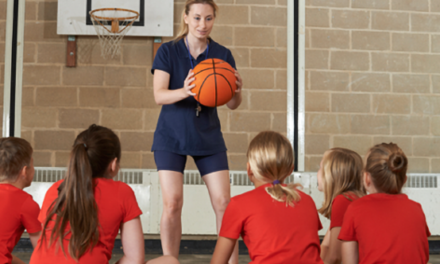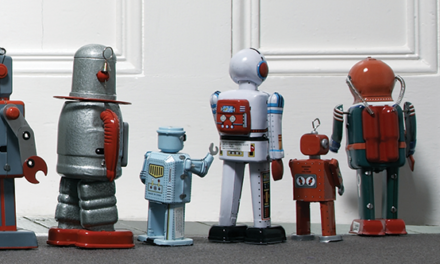Young adolescents are capable of so much more than people think.

Nancy Deutsch’s 3rd-grade daughter created this comic book cover illustrating what she believes middle school is like.
One afternoon during the heart of the COVID-19 pandemic, my daughter showed me a comic book she was writing titled Middle School Jitters. She was in 3rd grade but was a frequent consumer of books and television shows that featured young people navigating middle school. The illustration she had drawn for the cover was a scene from a middle school hallway. On one side was a large boy who had a smaller boy in a headlock and was yelling “nerd!” On the other side two students were kissing. Behind the students were rows and rows of identical lockers, making the scene look like it was taking place in an impenetrable fortress. In the foreground stood a girl, eyes wide, with a terrified look on her face. When I asked my daughter to tell me more about the picture, she said, “Mom, you’re remaking middle school. You should know how bad it is!’”
My heart sank. Over the past few years, I have been deeply involved in an initiative at Youth-Nex at the University of Virginia to help reshape middle schools. We use the science of adolescent development to engage middle grades educators in rethinking their schools’ structures and practices so that they’ll better align with young adolescents’ needs. And yet here was my own daughter parroting back all the stereotypes about the middle school experience that we are seeking to challenge.
The enduring narrative about middle school is that these years are extremely difficult, and the best students can do is power through them, hoping for some relief in high school. That stereotype is incomplete, and perpetuating it can have significant negative effects, including creating unnecessary anxiety in younger children. Talk to anyone who works in middle schools or with young adolescents, and they will tell you that these young adolescent years are more than what these stereotypes would lead you to believe; in fact, they are a time of tremendous potential and opportunity.
Stereotypes versus science
So why are these stereotypes so persistent? Why do we set kids up to believe that middle school will be a test of endurance? And, if we continue to perpetuate these stereotypes about middle school, what will it mean for our kids?
It is true that early adolescence, and thus middle school, is a time of great and rapid change (Lerner et al., 1996). And such change can bring volatility. But we don’t look with such dread at early childhood, the only time that equals or surpasses early adolescence in terms of the amount and speed of change (National Academies of Science, Engineering, & Medicine [NASEM], 2019).
Decades ago, Jacqueline Eccles and her colleagues (1993) coined the term “stage-environment fit,” positing that optimal outcomes occur when opportunities are provided within a context (be it a school, a home, or a community) that meets an individual’s developmental needs. Eccles and colleagues believed that many of the negative outcomes observed during the middle school years were a result not of the “fact” that early adolescence is a tumultuous time but of a mismatch between what middle schools offer (i.e., their structures and practices) and the needs of the young adolescent students. Joan Lipsitz’s (1984) case studies of successful middle schools, published a decade earlier, support this idea, presenting schools that seem to reflect the developmental alignment Eccles and her colleagues advocated.
The mismatch between what young adolescents need and what middle schools offer persists in many places, along with those nagging, negative stereotypes.
The science of adolescence has advanced dramatically since Eccles and colleagues put forth their theory and Lipsitz documented the practices and structures of successful schools for young adolescents (e.g., NASEM, 2019). There are increasing calls for using that science to guide policy, practice, and greater investment in the adolescent years (Dahl et al., 2018) and to inform our visions of what successful middle schools can look like (Association for Middle-Level Education, 2020). Yet the mismatch between what young adolescents need and what middle schools offer persists in many places, along with those nagging, negative stereotypes.
If we want our new knowledge about the science of adolescence to inform how our schools operate, we must challenge the stereotypes that continue to falsely shape our understanding of these years. We now have the information needed to flip the script, realign our ideas about young adolescents, and reshape middle schools to better meet students’ needs.
Stereotype 1: Young adolescents are risk-takers, so middle school should be all about mitigating risk.
One image that we see across our television screens — and hear as lore passed from generation to generation — is that students enter middle school likely to rebel, engage in impulsive behavior, and make poor decisions. Granted, there is a kernel of truth to this stereotype: During adolescence, studies show the brain becomes more responsive to dopamine, (Wahlstrom et al., 2010), a neurotransmitter that creates positive feelings and heightens teens’ appetites for novel, intense (and sometimes risky) experiences.
Yet the stereotype leads us astray in the assumption that all risk-taking is negative. In fact, an openness to taking risks often leads to innovation and social change. If harnessed correctly, we can use this predisposition by helping preteens and young teens direct their risk-taking energy toward pursuing intellectually stimulating experiences and new passions (Donovan, 2011) that can inform fulfilling hobbies, careers, and identities.
Empowering young adolescents to make meaningful contributions to their families, friends, and communities can trigger those feelings of reward, just as negative risk-taking can. So rather than ignore or suppress this developmental tendency, adults should encourage positive risk-taking in ways that nurture self-confidence, encourage intellectual curiosity, and inform young people’s independence. Remember, there is a reason young adolescents are wired for risk-taking: They are preparing to make the riskiest move of all — to leave their family of origin and eventually develop their own, independent lives. Providing positive, scaffolded opportunities for trying new things, and sometimes failing, prepares young adolescents for those greater risks down the road.
Stereotype 2: Middle schoolers’ brains are fully developed and incapable of change or immature and incapable of complex thinking.
Two competing and contradictory stereotypes are at play here. Yet somehow, as a society, we often manage to invoke both stereotypes when we approach young adolescents.
We have traditionally regarded early childhood as the most dynamic period of brain development and assumed that by early adolescence, the trajectory for a young person was largely set (save for the physical changes we are all familiar with). Recent advances in neuroscience, however, demonstrate that the adolescent brain is much more dynamic than we could have possibly imagined (e.g., NASEM, 2019; Williams, Mims, & Johnson, 2019). While connections between neurons grow at a breathtaking pace during adolescence, the brain simultaneously discards unused neurons and strengthens the ones that are most important to healthy development (Giedd, 2016). This discovery has led many to shift the narrative about teen brain development in the opposite direction, positioning adolescents as incapable of mature thought or cognition. But that is also a misinterpretation of the research.
Whereas certain sectors of the teenage brain are indeed still developing, others are fully formed, enabling adolescents to engage in complex thinking. The ability of the adolescent brain to realize its dynamic potential hinges on opportunities to experience ongoing enrichment; explore new pursuits; and engage in deeper, project-based learning (see, for example, Harper, Hermann, & Waite, 2018). A middle school experience defined by regurgitation of basic facts, passive learning, and disengagement is exactly the opposite of what students need at this stage.
The effect of these stereotypes about the young adolescent brain are twofold. First, academic tracks begin to calcify in middle school, a result of the assumption that students’ brain development is largely complete. Thus, students are set on a trajectory that determines their access to upper-level courses in high school, courses that serve as gatekeepers to higher education. Listening to students talk about how their “permanent record” begins in middle school, one gets the sense that they believe that whatever academic identity they have when they reach middle school is immutable and self-determining. This does not leave room for the flexibility and adaptability that we know are characteristics of the young adolescent brain.
Second, our assumption that middle school students aren’t capable of rational, complex thought leads us to exclude middle school students from opportunities to engage in real-world, meaningful problem solving. This is a time when young adolescents’ cognitive abilities are growing, which means that middle school students are primed to take advantage of engaging approaches to inquiry and learning. Further, they are hungry for real-life experiences that will allow them to feel like contributing members of their communities (contrary to other stereotypes I’ll discuss below). Providing supportive and scaffolded experiences that draw on students’ cognitive strengths is critical.
Stereotype 3: Middle schoolers do not care about adults.
We have all seen the image on television of a teenager walking in the door of their home, heading straight to their room, slamming their door, and focusing solely on their phone and their friends. It is true that young adolescents seek connection with and approval from peers and that friendships grow in importance and complexity during adolescence (Brown & Larson, 2009) as social rewards and group status become more important. Our knowledge about the adolescent brain reaffirms that young people are more likely to emphasize group status (LaFontana & Cillessen, 2010) over friendship, romance, or extracurricular pursuits.
However, this stereotype fails to consider the developmental imperative to value and establish strong connections with adults, especially individuals like after-school leaders, mentors, and community activists (Melton, Brehm & Deutsch, 2021). Adolescents often will seek out trusted adults to guide them as they navigate new relationships, shape their identities, and tackle new challenges. Teens also may feel more empowered to exercise their autonomy if they have the support of adults (Kansky, Ruzek, & Allen, 2017).
The ability of the adolescent brain to realize its dynamic potential hinges on opportunities to experience ongoing enrichment; explore new pursuits; and engage in deeper, project-based learning.
Yet it is often during middle school when students begin to switch classes more often and have less time and space during their day to develop strong relationships with school-based adults. The increased focus on academic content in middle school often comes with less attention to helping students to feel connected to their teachers. This is a missed opportunity to provide young adolescents with access to supportive, nonparental adults who can provide social support and role modeling. Practices like teaming and advisories that enable students and teachers to get to know each other are still important in middle school. Adults might assume that young adolescents don’t have any interest in talking to them, but that’s not necessarily the case. Even asking small questions about a student’s interests or life outside of school can make a student feel seen and noticed in a way that can foster an important sense of connection (Yu et al., 2018).
Stereotype 4: Middle schoolers are self-focused and not ready to be a force for positive change.
Although young adolescents spend a lot of time thinking about themselves, that’s not the whole story of what they’re about. Early adolescence is a time of tremendous identity exploration and development when young adolescents are figuring out who they are and where they fit in the world and asking important questions about their social identities, including race, gender, and sexuality (Williams, Mims, & Johnson, 2019). This does lead to some navel-gazing. But early adolescence is also a time of heightened social awareness and critical thinking, which leads young adolescents to explore how they fit into our social systems, to identify injustices in those systems, and to imagine possible places for themselves in society. This includes seeing the possibility of change and of their own potential to be change-makers (Heberle, Rapa, & Farago, 2020).
Traditionally, we have viewed the change-making efforts of young people with skepticism. We tend to assume that they are not ready to engage with adults to effect change and should wait until they have the proper set of experiences or education. But, at the same time, we have seen the widespread grassroots actions young people have taken during the last five years to advocate for racial justice, combat climate change, stave off gun violence, support immigrants, and protect reproductive rights. Not only is this stereotype of young people disproved by recent events, but adolescents have long been trendsetters and groundbreaking visionaries, leading the way during the civil rights era, Vietnam War, and social movements at the end of the 20th century.
Whereas we may think of these movements as being led by older youth, young adolescents are also well-poised to make contributions. Marley Dias, for example, created #1000BlackGirlBooks at the age of 10 as a response to her own experiences with the English curriculum at her school. Young adolescents’ growing inclination toward autonomy, independence, and risk-taking behavior particularly primes them for spearheading social transformations. Experiences in middle school provide important opportunities for developing needed skills for effective civic participation and leadership. Because early adolescence is a time when identity development is central, such experiences may also make it more likely that youth will integrate into their identities an image of themselves as change-makers. Habits develop due to repetition, and because the adolescent brain is “sticky” (i.e., it is taking in and holding onto new experiences), engagement in social change movements during early adolescence can further support the “habit” of lifetime civic participation. By incorporating opportunities for meaningful, real-world engagements into the middle school curriculum, we can meet young adolescents’ needs to see themselves as having agency in the world and capitalize on their energy and creativity to help us adults see new ways of moving forward.
A vision for middle schools that work for students
So what might a middle school that works for students look like? And how can educators combat stereotypes in their school or classroom? Here are a few ideas:
- Engage students in project-based, student-centered learning that offers opportunities for students to enact their growing sense of autonomy and explore and express their identities.
- Practice iterative pedagogies that allow students to take risks and learn from mistakes. For example, introduce maker projects that expect failure as part of the process of coming up with an answer.
- Instead of traditional grades, try mastery approaches to assessment that engage students in thinking about their own learning and promote a growth mindset.
- Build advisories or morning meetings into the school day to allow teachers dedicated time and a structure for fostering both student-teacher and peer relationships.
- Include scaffolded opportunities for students to engage in public discourse about a topic that is important to them. For example, have students identify a current issue that they are concerned about, research the issue, and write a letter to an elected official or decision maker.
You can read more about these ideas, as well as other suggestions, and the science that underlies them, in Youth-Nex’s Remaking Middle School working papers.
As we reimagine and remake middle school, it is important that we equip our educators, principals, and community leaders to work together to structure middle school in ways that support student agency, address local challenges that are relevant to their lived experiences, and inspire engagement. Young people are clamoring for these opportunities and have the capacity — and drive — to lead the way.
References
Association for Middle-Level Education. (2020). The successful middle school: This we believe. Author.
Brown, B.B. & Larson, J. (2009). Peer relationships in adolescence. In R.M. Lerner & L. Steinberg (Eds.), Handbook of adolescent psychology (pp. 74-103). John Wiley & Sons.
Dahl, R., Allen, N., Wilbrecht, L., & Suleiman, A.B. (2018). Importance of investing in adolescence from a developmental science perspective. Nature, 554, 441-450.
Donovan, E. (2011, July 11). Risky business: Why teens need risk to thrive and grow. Psychology Today.
Eccles, J.S., Midgley, C., Wigfield, A., Buchanan, C.M., Reuman, D., Flanagan, C., & Mac Iver, D. (1993). Development during adolescence: The impact of stage-environment fit on young adolescents’ experiences in schools and in families. American Psychologist, 48 (2), 90-101.
Giedd, J. (2016). The amazing teen brain. Scientific American, 25 (2s), 92-97.
Harper, R., Hermann, H., & Waite, W. (2018). Science of adolescent learning: How body and brain development affect student learning. Alliance for Excellent Education.
Heberle, A.E., Rapa, L.J., & Farago, F. (2020). Critical consciousness in children and adolescents: A systematic review, critical assessment, and recommendations for future research. Psychological Bulletin, 146 (6), 525.
Kansky, J., Ruzek, E., & Allen, J. (2017). Observing adolescent relationships: Autonomy processes in parent, peer, and romantic partner interactions. In B. Soenens, M. Vansteenkiste, & S. Van Petegem (Eds.), Autonomy in adolescent development (pp. 33-52). Routledge: Psychology Press.
LaFontana, K.M. & Cillessen, A.H. N. (2010). Developmental changes in the priority of perceived status in childhood and adolescence. Social Development, 19 (1), 130-147.
Lerner, R.M., Lerner, J.V., von Eye, A., Ostrom, C.W., Nitz, K., Talwar-Soni, R., & Tubman, J.G. (1996). Continuity and discontinuity across the transition of early adolescence: A developmental contextual perspective. In A.C. Petersen, J. Brooks-Gunn, & J.A. Graber (Eds.), Transitions through adolescence (pp. 3-22). Routledge: Psychology Press.
Lipsitz, J. (1984). Successful schools for young adolescents. Routledge.
Melton, T.N., Brehm, M.V., & Deutsch, N.L. (2021). Broadening the perspective on youth’s systems of support: An ecological examination of supportive peer and adult relationships during adolescence. Journal of Community Psychology, 49 (5), 1334-1357.
National Academies of Sciences, Engineering, and Medicine. (2019). The promise of adolescence: Realizing opportunity for all youth. The National Academies Press.
Wahlstrom, D., Collins, P., White, T., & Luciana, M. (2010). Developmental changes in dopamine neurotransmission in adolescence: Behavioral implications and issues in assessment. Brain and Cognition, 72 (1), 146-159.
Williams, J.L., Mims, L.C., & Johnson, H.E., (2019). Young adolescent development (Working Paper). Youth-Nex: The UVA Center to Promote Effective Youth Development.
Yu, M.V.B., Johnson, H.E., Deutsch, N.L., & Varga, S.M. (2018). “She calls me by my last name”: Exploring adolescent perceptions of positive teacher-student relationships. Journal of Adolescent Research, 33 (3), 332-362.
This article appears in the October 2022 issue of Kappan, Vol. 104, No. 2, pp. 6-10.
ABOUT THE AUTHOR

Nancy L. Deutsch
Nancy L. Deutsch is the Linda K. Bunker Professor of Education and Director of Youth-Nex at the University of Virginia School of Education and Human Development, Charlottesville.












